QGIS SWMM Outfalls Fix Multiply Connected Links: Difference between revisions
Created page with "== Introduction == This tool converts junctions on the downstream side of a network to outfall nodes as required by SWMM. This tool uses the "From node" and "To Node" fields t..." |
|||
| Line 1: | Line 1: | ||
== Introduction == |
== Introduction == |
||
This tool creates a conduit extension to eliminate the SWMM error with multiple links connected to the same outfall node. This is a common issue when converting ESTRY models for use in TUFLOW-SWMM. This tool takes an existing GeoPackage file and creates a new GeoPackage file that contains the channel extensions. The newly created extension channel is always an open rectangular channel with the provided attributes. The generated channels may need to be modified to match the real world geometry at the location. |
|||
This tool converts junctions on the downstream side of a network to outfall nodes as required by SWMM. This tool uses the "From node" and "To Node" fields to determine position in the network. Ensure that these fields are populated and up to date.<br> |
|||
'''Note:''' It is recommended to use the <u>[[QGIS SWMM Conduits Assign Node Fields|Conduits - Assign Node Fields]]</u> tool and the <u>[[QGIS SWMM Integrity Make Node Names Unique|Integrity - Make Node Names Unique]]</u> tool to avoid errors when running the simulation. |
|||
<br> |
<br> |
||
Revision as of 16:36, 13 December 2023
Introduction
This tool creates a conduit extension to eliminate the SWMM error with multiple links connected to the same outfall node. This is a common issue when converting ESTRY models for use in TUFLOW-SWMM. This tool takes an existing GeoPackage file and creates a new GeoPackage file that contains the channel extensions. The newly created extension channel is always an open rectangular channel with the provided attributes. The generated channels may need to be modified to match the real world geometry at the location.
Usage
This tool can be found in the QGIS processing toolbox panel under 'TUFLOW > SWMM'. To open the Processing Toolbox Panel, navigate to 'Processing' in the menubar and select 'Toolbox'.

Parameters
- Input junctions: Use the dropdown menu to select the existing junctions layer that will be updated.
- Input conduits: Select the ... button and tick on the conduits layer that the junctions are snapped to.
- New outfalls layer: Determines the output file. Details on the options are below.
Output Options:
For each of the following options, the tool will create a new outfalls layer and won't overwrite the existing one.
- Create Temporary Layer:
- Creates a temporary scratch layer. This layer will open into the QGIS workspace but it will not be saved anywhere.
- Save to File...:
- The user can navigate to a folder and save the updated outfalls layer to a new GeoPackage Database.
- Save to GeoPackage...:
- Save to Database Table...:
- ???
- Append to Layer...:
- ???
Example
| Up |
|---|
